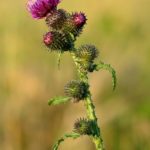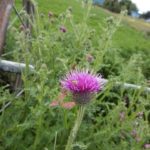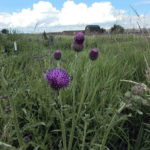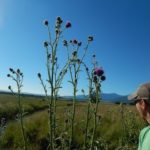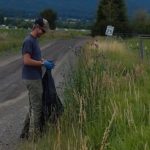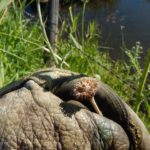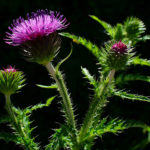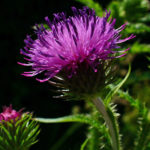Gallery:
Common names:
Welted thistle, curly plumeless thistle
Scientific Name:
Carduus crispus
Description:
A large growing thistle Stems are openly branching, hairy with curled hairs to nearly smooth. Stems have spiny wings to 1.5 cm wide, and sport wing spines 3 mm long. The leaves have winged petioles at their base. Leaf blades are 10–20 cm long with spiny-toothed margins. Flower heads are borne singly or in groups of 2–5, 15–18 mm wide. Flower peduncles are spiny-winged to near apex or throughout, to 4 cm wide. Flower corollas can be either purple or white. Flower parts are both male and female. Insect pollination is required. Reproduction is entirely by seed. Carduus crispus closely resembles the more common C. acanthoides (plumeless thistle).
Life cycle:
Annual to biennual
Height of mature plants
1- 5 feet
Flower color:
Purple or pink to white
Bloom time:
Flowering occurs July through September.
Look-a-likes:
Similar to other thistles. Very closely resembles the more common plumeless thistle (Carduus acanthoides)
Habitat:
irrigation ditches, field margins, waste ground, pastures, and roadsides
Impacts:
Likely contaminant in grass and alfalfa hay, reducing its quality and marketability. Welted thistle seeds may also be a contaminant in alfalfa, grain, or grass seed. Infested grasslands and pastures may see a reduction in productivity when thistle densities reach high levels. This spiny thistle would act as a deterrent to most grazing.
Noxious Weed Listing:
- WeedWise: Priority
- State of Oregon: Class A,T
- State of Washington: not listed
- Four County CWMA: not listed
Origin:
Native to Europe and Asia. The first record of welted thistle occurred in the Eastern U.S. in 1974. In 2016, a new western infestation was detected in Wallowa County, Oregon.
Present in Clackamas County:
Not known to occur
Links:
Oregon Noxious Weed Risk Assessment

